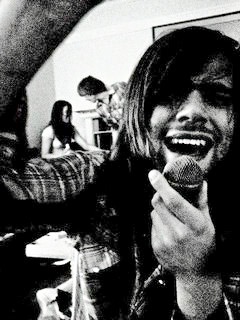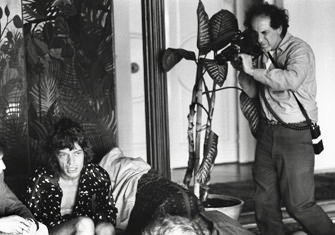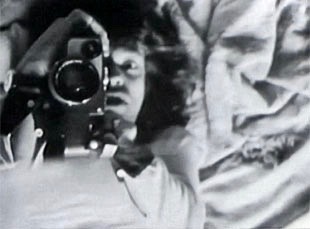
Photographer/filmmaker Robert Frank (left) and Mick Jagger (right) on The Rolling Stones’ private jet during their 1972 tour of the U.S. to promote the album “Exile on Main Street” as depicted in the rock documentary Cocksucker Blues (1972).
After being withheld from release for 15 years, Gerald Fox’s Leaving Home, Come Home: A Portrait of Robert Frank, is finally receiving a U.S. theatrical release. Famous for his seminal 1958 collection “The Americans,” Swiss-born photographer Frank is no stranger to films being withheld from public viewing and one of his most infamous projects C*cksucker Blues, a behind-the-scenes account of The Rolling Stones’ 1972 tour of America, remains unreleased to this day.
 Coming up on its 47th anniversary, this controversial collaboration between The Rolling Stones and Frank is much less obscure than you’d think and has been hiding in plain sight for years. Easily available in poor quality bootleg copies (you can even see major portions, if not all of it, on YouTube), C*cksucker Blues is much more intriguing now than it was in 1972 and its one-time notoriety looks undeserved from the safe distance of 2019.
Coming up on its 47th anniversary, this controversial collaboration between The Rolling Stones and Frank is much less obscure than you’d think and has been hiding in plain sight for years. Easily available in poor quality bootleg copies (you can even see major portions, if not all of it, on YouTube), C*cksucker Blues is much more intriguing now than it was in 1972 and its one-time notoriety looks undeserved from the safe distance of 2019.

A typical example of the poor video quality bootleg VHS copies of Robert Frank’s Cocksucker Blues (1972)
For years I only had access to a lousy VHS dupe of the film from Video Search of Miami. But when I was going through my DVD collection recently, I came across a bootleg DVD of C*cksucker Blues that I didn’t remember owning. It must have been a gift from a friend and I had forgotten about it. When I slipped it into the DVD player to check the quality, I was surprised to see how good it looked. I had even forgotten that it was shot in color, some of it quite subtle and muted, some of it shot with a blue filter and some of it with a slight sepia tint. I suppose I had always assumed it was shot in black and white because the smeary quality of the sixth or seventh generation dupe I had watched transformed everything into gray muck.

The Rolling Stones minus Keith Richards and an unidentified groupie during the filming of Robert Frank’s Cocksucker Blues (1972).
Watching C*cksucker Blues again, I was struck by its deceptively haphazard but often artful visual style – not all of it shot by Frank but more on that later – which was edited by Susan Steinberg and Paul Justman in a manner that appropriated Frank’s aesthetic approach to both photography and film. I was also impressed by the film’s stark and unromanticized look at the most famous – and at the time – most popular rock ‘n roll band in the world.
The C*cksucker Blues project grew out of the “Exile on Main Street” album. Mick Jagger had hired Frank to shoot and design the famous album cover and begin entertaining the idea of having Frank shoot the definitive Rolling Stones movie as well. After all, Frank was also a filmmaker, having made the highly influential Beat Generation short, Pull My Daisy, in 1959 with Jack Kerouac providing the narration and appearances by poets and artists such as Allen Ginsberg, Gregory Corso, Larry Rivers, David Amram, Peter Orlovsky, Alice Neel and Delphine Seyrig. 
Even though The Rolling Stones – and Jagger in particular – had already experienced an enormous amount of negative publicity for their association and involvement in the 1969 Altamont, California concert (in which Hell’s Angels members beat and stabbed to death a concert attendee on camera), and which was later immortalized in the 1970 Maysles Brothers’ documentary, Gimme Shelter, the band was still open to the idea of a film that would truly capture their milieu and essence. In trying to describe his approach, Frank told Keith Richards, “It’s verite”. “Never mind verite,” Richards responded, “I want poetry.” And Mick wanted poetry too and couldn’t resist the hipster factor of having Frank immortalize them on film like he had with the Beat poets in the late fifties.

Keith Richards strumming his guitar on The Rolling Stones’ private jet in a scene from Cocksucker Blues (1972), directed by Robert Frank
The result of the collaboration WAS an art film but after Frank screened it for the Stones Jagger decided to shelve it, telling him, “It’s a fucking good film, Robert, but if it shows in America we’ll never be allowed in the country again.” And Jagger was probably correct in his assessment because C*cksucker Blues captures the worst aspects of the rock ‘n roll decadence that has always been a part of the band’s mystique – the drug dealers, the groupies, the hanger-ons, sex orgies, and the sort of cruel, destructive behavior that arises from complete boredom and results in people being abused (usually groupies), rooms being trashed and TVs being tossed from balconies. It’s quite possible civic leaders, conservative politicians and law enforcement agencies would have indeed protested and blocked the film’s distribution at the time as a negative influence on America’s youth. But Jagger surmised that most Rolling Stones fans probably wouldn’t like it either.
If Jagger had really been an astute observer of Frank’s work and familiar with the artist’s photographic oeuvre and earlier films such as The Sin of Jesus (1961), O.K. End Here (1963) or Me and My Brother (1969), he would have realized that C*cksucker Blues was doomed to commercial failure. 
Frank has always taken an ironic and subjective approach to his work, finding alienation, loneliness and an undefinable sadness amid urban settings and landscapes and especially in the faces of people living in what is supposed to be the greatest nation on earth. It is the tedium of day to day existence, the inability to connect with others, the disappointments and dashed dreams of people left behind by the American dream that informs Frank’s best work. And when you apply this approach to a glam rock group like the Rolling Stones, all the fantasy, high times and fun are stripped away, revealing a strangely claustrophobic world with little connection to the real one and no sense of life being lived; everyone appears to be in some kind of limbo, waiting for something to happen or at least some kind of closure like the end of the tour. In this way, C*cksucker Blues is much closer in tone to a Samuel Becket play like Waiting for Godot than a rock documentary.

Mick Jagger and Keith Richards in a scene from the long-suppressed rock documentary Cocksucker Blues (1972), directed by Robert Frank.
It’s obvious that the Stones did have second thoughts once Frank and his assistant, Danny Seymour (who also functioned as the sound man and drug connection for the band), began shooting. The filmmakers even provided additional cameras for the band and crew, encouraging them to shoot footage even when there was nothing going on (Some of this found its way into the finished movie such as Mick filming himself on the bed and masturbating).
“One of the rules when making the movie,” according to co-editor Paul Justman in an interview with John Robinson of The Guardian, “was that none of the people in the Rolling Stones could say no. If they said no, then Robert put the camera down and he left. There wouldn’t be any anger or anything. It would be like, ‘OK, you guys have given up and said no to me. Get someone else.’

A scene from Robert Frank’s Cocksucker Blues, a behind-the-scenes look at the 1972 US concert tour of The Rolling Stones.
Still, there are plenty of times in the film when you can see the Stones’ unease with the filmmakers and occasionally signaling them to stop shooting. Their reluctance to be the main subject is one reason why some of the roadies, groupies, fans, ticket scalpers and lesser known musicians play a larger part in the footage; a cocaine dealer, stoned out of his gourd, says to the cameraman, “It’s just too expensive to develop a habit”; a nude woman, sprawled zombie-like on an unmade bed, directs attention to her exposed privates, a distraught ticket buyer threatens suicide if she can’t get in to see the concert, admitting that she’s lost custody of her child because she’s on acid all the time (“So what? He was born on acid!”), a groupie shoots up heroin and then asks the cameraman, “Why did you film that?”
Lacking the professional slickness of rock documentaries such as Woodstock (1970) or Mad Dogs & Englishmen (the 1971 Joe Cocker rock documentary), C*cksucker Blues also drew criticism for its seemingly sloppy visual sense. “Technically, it was a complete mess,” said co-editor Susan Steinberg in an interview with The Guardian. “There was a light leak in the [camera] magazine. Most people who saw this happening would have got the light leak fixed or got a new magazine, but Robert didn’t. He didn’t believe in that, and it’s that attitude that’s very prevalent in the film. It’s down and dirty.”

Photographer/filmmaker Robert Frank (right) shooting Mick Jagger during the making of Cocksucker Blues (1972).
Despite the dim commercial prospects for C*cksucker Blues, Frank, who owned the copyright, attempted to gain control of his film despite the Rolling Stones’ self-imposed ban on it and the case went to court. A compromise was reached in which Frank was allowed to screen the movie no more than five times a year and he had to be present at the screenings.
Frank would later admit, in an interview with Robert Greenfield, author of S.T.P: A Journey Through America With the Rolling Stones, “I have never been on anything like this before. I have been on trips with extraordinary people, but nothing that so totally excludes the outside world. To never get out, to never see anything…I am not used to it.”

Keith Richards appears zonked out in this scene from Robert Frank’s infamous Rolling Stones portrait, Cocksucker Blues (1972).
Among the more famous scenes in C*cksucker Blues is the so-called orgy on the private jet which involves a shot of a naked copulating couple, lots of female nudity, the liberal and abundant use of alcohol, pot and whipped cream, and Mick and Keith providing rhythmic accompaniment to the party. The scene is also alleged to have been one of the few “staged” scenes in the movies and was inadvertently prompted by Frank.

The film poster for Gerald Fox’s 2004 documentary on Robert Frank, Leaving Home, Coming Home, which is finally receiving a theatrical release in 2019.
In an interview with Border Crossings Magazine, the filmmaker reiterated, “They [the Rolling Stones] didn’t want me to make the film. They enjoyed having us around but not to film. I was with my friend Danny and he had good connections for dope, much better than they had. And at one point I said to him nothing ever happens on these plane trips. It would be nice to have something happen….That was one of the few things I said in all the time we spent on the plane. When the film came out the Stones agreed not to cut anything, although I had to cut some things with the officials from the record company. That’s what adds up; your experience. Making a film is an experience really; more so than going around photographing. Making a film is a real trip.”

Mick Jagger and Keith Richards in concert from the Robert Frank documentary Cocksucker Blues (1972).
If I have painted C*cksucker Blues as being a real downer of a movie, let me say that there are exhilarating moments (rousing concert footage of Mick performing “Street Fighting Man” and “Midnight Rambler”) and even poetic ones amid the darkness (a quiet, withdrawn Bianca Jagger listening to a wind-up music box in her room alone).
There are even some laugh out loud moments – a disoriented Keith Richards having great difficulty trying to order a fruit tray from room service and exclaiming in exasperation, “This is too complicated!” There is also much amusement to be had by the now-absurd and outlandish stage outfits Jagger squeezes his skinny body into before each performance – the foppish white top hat, the tight star-spangled pants, the flowing neck scarves, the wide, colorful waist sashes, the broad shouldered, tapered jackets.

Stevie Wonder (left) was the opening act for The Rolling Stones during their 1972 US concert tour as seen in the film Cocksucker Blues, directed by Robert Frank.
For celebrity watchers, the film is chock full of surprise cameo appearances by such pop culture celebrities as Andy Warhol, Princess Radziwill, Truman Capote, novelist Terry Southern (Candy, The Magic Christian), Dick Cavett, who asks Bill Wyman “What’s running through your nervous system right now?,” Atlantic Records mogul Ahmet Ertegun, Tina Turner in her sexy, gorgeous prime and Stevie Wonder, who almost steals the show in brief clips of his concert scenes performing “Uptight (Everything’s Alright)” and a duet with Mick on “Satisfaction.” (Wonder was the opening act for the Stones during their 1972 tour in support of “Exile on Main Street.”)

A scene from Robert Frank’s behind-the-scenes portrait of The Rolling Stones, Cocksucker Blues (1972) featuring Mick Jagger.
My favorite section of C*cksucker Blues is a brief detour the Stones make during their tour to sightsee along the byways of the South, looking for some good roadhouse food. It’s one of the few moments in the film that takes place away from the drab hotel rooms or artificially lit backstage corridors and dressing rooms of the concert halls. While the drive is uneventful – Mick remarks at one point, “This is the most uninteresting drive in the world! – he later defends his Southern detour by stating, “In the South, they really do have good food, even in the coffee shops….and slaves!” 
At this late date, C*cksucker Blues is no longer shocking or even depressing, at least for me. Instead, it evokes something close to nostalgia for a period in the early seventies when rock ‘n roll really was about self-absorption, hedonism and decadence. And it’s an invaluable document of its era and of the Stones at that point in their career. As filmmaker Jim Jarmusch stated after seeing it, “definitely one of the best movies about rock and roll I’ve ever seen…It makes you think being a rock and roll star is one of the last things you’d ever want to do.”

Director Robert Frank (far right) filming backstage with Mick Jagger in background for the 1972 documentary Cocksucker Blues.
Now that The Rolling Stones have become a corporate brand as powerful and popular as Coca-Cola and Apple, I doubt a 47-year-old documentary would have any effect on their popularity. I think the world is finally ready for C*cksucker Blues so let the ban be lifted. It’s a Robert Frank film and demands to be seen as one of his key works.
Other websites of interest:
https://www.nga.gov/press/backgrounder/bio-robertfrank.html
https://www.theartstory.org/artist-frank-robert-life-and-legacy.htm
https://variety.com/2016/film/columns/the-rolling-stones-robert-frank-1201819197/
https://www.rollingstone.com/music/music-news/the-trouble-with-cocksucker-blues-237858/
https://www.youtube.com/watch?v=Op_TR2mdzhw






